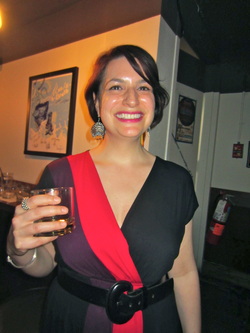 Peat was the star of the "Smoke in the Water" whisky roundtable at Idle Hands. When one taster said the starter whisky - a 15-year Bowmore - was too smoky, the organizer said, "This may be a downward spiral into Hell for you." It was just the beginning of the fiery Heaven for me. Up for tasting was four Scotches and two smoky American whiskeys led by a roundtable of three whiskey experts - including two women! - Amanda Schuster, writer for Wine and Spirits, whisky expert Karl du Hoffman, and Carmen Operetta, a self-described whiskey ambassador. A hipster crowd filled the bar where whisky settings topped barrels, the bar and every available table.  Karl duHoffmann And I was the whiskey dork, sitting front and center, learning forward on my stool to catch every little tidbit about how peat is created. I've never cared much for botany and studying decomposing matter, but when it helps explain why my whiskey tastes like a campfire, bring it on. [A few of my notes on peat: it is decomposing organic matter that is black because it is so high in carbon. Sounds delicious. In Scotland, they use it for heat. In Scotch, the barley is dried over a fire burning peat before it is used in the whisky-making, which gives it that campfire/pipe/cowboy boot smell.] The Bowmore 15-year we started with was slightly smoky - the smokiness fades with age, we learned. It is aged in bourbon barrels and then oloroso sherry oak casks, to give a nice balance of smoky and sweet. "This one is not as fierce as the others," Carmen said. Or, as Karl put it as we moved on to the next one, "The training wheels are off." The second whiskey was American, a Corsair Triple Smoke, but the maker had studied whisky-making at the Bruichladdich distillery in Scotland, so the taste was more Scotch than American. It was triple-smoked with Scottish peat, German beechwood, and American cherry wood, which gave it a distinct wood flavor different than a typical smoky Scotch.  Carmen Operetta For the next whisky, Carmen encouraged us to try a little seduction - approach slowly, smell from every angle of the glass, hold a sip in the mouth 10 seconds, swallow, then blow out the breath slowly. And the flavors lit up around the mouth - black pepper, cinnamon, campfire, brininess. This was a Port Charlotte An Turas Mor from the Bruichladdich distillery where Carmen - lucky one! - spent some time learning about whisky. Carmen didn't start out a Scotch drinker, though - she started drinking whiskey by stealing nips from her dad's Canadian blends when growing up in Detroit. She didn't discover single malts until she moved to New York City, where she worked in a whiskey/cigar bar and fell in love with Scotch. "Laphroaig crossed me over and turned me out," she said. Amanda found an earlier start - not too long after solid food - when she toddled over to her parents' table at age two, drank some whiskey they had left sitting there, and told her surprised parents when they walked back in, "mmmm, whiskey juice." (Advice I stashed away for how to raise a whiskey connoisseur.)  Amanda Schuster Back to America for our fourth whiskey - Texas this time for a little Balcones Brimstone. No peat involved here - the smoke is infused after the distilling. It's blue corn whiskey and evokes bbq and dry brush and tumbleweeds in the same way you can imagine the salty, rocky shores when sipping a Scotch. It was the fifth whisky - Port Charlotte PC7 - that got fierce. It was so smoky, it was tangy. The first sip overwhelmed me, like cliff jumping into deep water. You like it, but it's challenge and a rush that calls you back.I added a few drops of water and went back in for more. Our last whiskey of the afternoon sounded sci - fi: "The Octomore 3_152," which claims to be the peatiest whisky on earth. "You know you shouldn't do it, but you do it anyway," said Karl. And we did, happily. Comments are closed.
|
Archives
November 2017
|

 RSS Feed
RSS Feed
